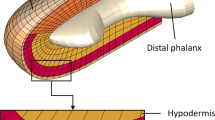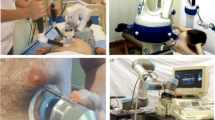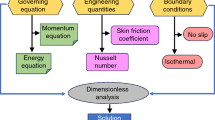Abstract
Haptics provides sensory stimuli that represent the interaction with a virtual or tele-manipulated object, and it is considered a valuable navigation and manipulation tool during tele-operated surgical procedures. Haptic feedback can be provided to the user via cutaneous information and kinesthetic feedback. Sensory subtraction removes the kinesthetic component of the haptic feedback, having only the cutaneous component provided to the user. Such a technique guarantees a stable haptic feedback loop, while it keeps the transparency of the tele-operation system high, which means that the system faithfully replicates and render back the user’s directives. This work focuses on checking whether the interaction forces during a bench model neurosurgery operation can lie in the solely cutaneous perception of the human finger pads. If this assumption is found true, it would be possible to exploit sensory subtraction techniques for providing surgeons with feedback from neurosurgery. We measured the forces exerted to surgical tools by three neurosurgeons performing typical actions on a brain phantom, using contact force sensors, while the forces exerted by the tools to the phantom tissue were recorded using a load cell placed under the brain phantom box. The measured surgeon–tool contact forces were 0.01–3.49 N for the thumb and 0.01–6.6 N for index and middle finger, whereas the measured tool–tissue interaction forces were from six to 11 times smaller than the contact forces, i.e., 0.01–0.59 N. The measurements for the contact forces fit the range of the cutaneous sensitivity for the human finger pad; thus, we can say that, in a tele-operated robotic neurosurgery scenario, it would possible to render forces at the fingertip level by conveying haptic cues solely through the cutaneous channel of the surgeon’s finger pads. This approach would allow high transparency and high stability of the haptic feedback loop in a tele-operation system.





Similar content being viewed by others
References
Salisbury K, Conti F, Barbagli F (2004) Haptic rendering: introductory concepts. IEEE Comput Graphics Appl 24(2):24–32
Salcudean S, Ku S, Bell G (1997) Performance measurement in scaled teleoperation for microsurgery, in CVRMed-MRCAS’97. Springer, pp. 789–798
De Lorenzo D, De Momi E, Conti L, Votta E, Riva M, Fava E, Bello L, Ferrigno G (2013) Intraoperative forces and moments analysis on patient head clamp during awake brain surgery. Med Biol Eng Comput 51(3):331–341
De Lorenzo D, De Momi E, Dyagilev I, Manganelli R, Formaglio A, Prattichizzo D, Shoham M, Ferrigno G (2011) Force feedback in a piezoelectric linear actuator for neurosurgery. Int J Med Robot Comput Assist Surg 7(3):268–275
De Lorenzo D, Koseki Y, De Momi E, Chinzei K, Okamura A (2013) Coaxial needle insertion assistant with enhanced force feedback. IEEE Trans Biomed Eng 60(2):379–389
Massimino M, Sheridan T (1994) Teleoperator performance with varying force and visual feedback. Hum Factors J Hum Factors Ergon Soc 36(1):145–157
Moody L, Baber C, Arvanitis TN et al (2002) Objective surgical performance evaluation based on haptic feedback. Stud Health Technol Inf 85(2):304–310
Wagner C, Stylopoulos N, Howe R (2002) The role of force feedback in surgery: analysis of blunt dissection. In: Symposium on haptic interfaces for virtual environment and teleoperator systems, Citeseer, pp 73–79
Lang M, Sutherland G (2010) Informatic surgery: the union of surgeon and machine. World Neurosurg 74(1):118–120
Guidali M, Duschau-Wicke A, Broggi S, Klamroth-Marganska V, Nef T, Riener R (2011) A robotic system to train activities of daily living in a virtual environment. Med Biol Eng Comput 49(10):1213–1223
Ellis R, Ismaeil O, Lipsett M (1996) Design and evaluation of a high-performance haptic interface. Robotica 14(03):321–327
Okamura AM (2004) Methods for haptic feedback in teleoperated robot-assisted surgery. Ind Robot Int J 31(6):499–508
Lederman S (1991) Skin and touch. Encycl Hum Biol 7:51–63
Sherrick C, Craig J (1982) The psychophysics of touch: a sourcebook. Tactual perception, p 55
Goethals P (2008) Tactile feedback for robot assisted minimally invasive surgery: an overview. In: Internal Report, Department of Mechanical Engineering KU Leuven
Sherrick C, Cholewiak RW (1986) Cutaneous sensitivity. Handb Percept Hum Perform 1:1–12
Hale K, Stanney K (2004) Deriving haptic design guidelines from human physiological, psychophysical, and neurological foundations. IEEE Comput Graphics Appl 24(2):33–39
Jones L (2000) Kinesthetic sensing. In: Human and machine haptics. MIT Press
Hashtrudi-Zaad K, Salcudean S (2002) Transparency in time-delayed systems and the effect of local force feedback for transparent teleoperation. IEEE Trans Robot Autom 18(1):108–114
Franken M, Stramigioli S, Misra S, Secchi C, Macchelli A (2011) Bilateral telemanipulation with time delays: a two-layer approach combining passivity and transparency. IEEE Trans Robot 27(4):741–756
Bach-y Rim P, Webster J, Tompkins W, Crabb T (1987) Sensory substitution for space gloves and for space robots. In: Proceedings IEEE international conference on robotics and automation, vol 2. ICRA, pp 51–57
Massimino M (1995) Improved force perception through sensory substitution. Control Eng Pract 3(2):215–222
Prattichizzo D, Pacchierotti C, Rosati G (2012) Cutaneous force feedback as a sensory subtraction technique in haptics. IEEE Trans Haptics 5(4):289–300
Pacchierotti C, Tirmizi A, Prattichizzo D (2013) Improving transparency in eleoperation by means of cutaneous tactile force feedback. ACM Trans Appl Percept 11:4
Mihelj M, Podobnik J (2012) Haptic displays. In: Haptics for virtual reality and teleoperation, Series Intelligent Systems, Control and Automation: Science and Engineering, vol 64. Springer, Netherlands, pp 57–73
Miller K, Chinzei K, Orssengo G, Bednarz P (2000) Mechanical properties of brain tissue in-vivo: experiment and computer simulation. J Biomech 33(11):1369–1376
Sutherland G, Wolfsberger S, Lama S, Zarei-nia K (2013) The evolution of neuroArm. Neurosurgery 72:A27–A32
Chen Z, Gillies G, Broaddus W, Prabhu S, Fillmore H, Mitchell R, Corwin F, Fatouros P (2004) A realistic brain tissue phantom for intraparenchymal infusion studies. J Neurosurg 101(2):314–322
Marcus H, Zareinia K, Gan L, Yang F, Lama S, Yang G-Z, Sutherland G (2014) Forces exerted during microneurosurgery: a cadaver study. Int J Med Robot Comput Assist Surg 10(2):251–256
Maddahi Y, Gan LS, Zareinia K, Lama S, Sepehri N, Sutherland G (2015) Quantifying workspace and forces of surgical dissection during robot-assisted neurosurgery. Int J Med Robot Comput Assist Surg
Howard M III, Abkes B, Ollendieck M, Noh M, Ritter R, Gillies G (1999) Measurement of the force required to move a neurosurgical probe through in vivo human brain tissue. IEEE Trans Biomed Eng 46(7):891–894
Sharp A, Ortega A, Restrepo D, Curran-Everett D, Gall K (2009) In vivo penetration mechanics and mechanical properties of mouse brain tissue at micrometer scales. IEEE Trans Biomed Eng 56(1):45–53
Jensen W, Yoshida K, Hofmann U (2006) In-vivo implant mechanics of flexible, silicon-based acreo microelectrode arrays in rat cerebral cortex. IEEE Trans Biomed Eng 53(5):934–940
Rosen J, Hannaford B, Richards CG, Sinanan MN (2001) Markov modeling of minimally invasive surgery based on tool/tissue interaction and force/torque signatures for evaluating surgical skills. IEEE Trans Biomed Eng 48(5):579–591
Parittotokkaporn T, Frasson L, Schneider A, Huq S, Davies BL, Degenaar P, Biesenack J, Rodriguez y Baena F (2009) Soft tissue traversal with zero net force: feasibility study of a biologically inspired design based on reciprocal motion. In: IEEE international conference on robotics and biomimetics, ROBIO. IEEE, pp 80–85
Ritter RC, Quate E, Gillies G, Grady M, Howard IMA, Broaddus W (1998) Measurement of friction on straight catheters in in vitro brain and phantom material. IEEE Trans Biomed Eng 45(4):476–485
De Lorenzo D, Manganelli R, Dyagilev I, Formaglio A, De Momi E, Prattichizzo D, Shoham M, Ferrigno G (2010) Miniaturized rigid probe driver with haptic loop control for neurosurgical interventions. In: Proceedings IEEE-RAS EMBS international conference on biomedical robotics and biomechatronics, BioRob. IEEE, pp 522–527
LabVIEW System Design Software, National Instruments Corporation. http://www.ni.com/labview/
The OROCOS Project. http://www.orocos.org/
Gefen A, Margulies S (2004) Are in vivo and in situ brain tissues mechanically similar? J Biomech 37(9):1339–1352
Prattichizzo D, Trinkle JC (2008) Grasping. In: Springer handbook of robotics. Springer, pp 671–700
Acknowledgments
The authors acknowledge the contribution of Danilo De Lorenzo for his assistance with the acquisition setup. The research leading to these results has received funding from the European Union Seventh Framework Programme FP7/2007–2013 under Grant Agreement No. 270460 of the project “ACTIVE: Active Constraints Technologies for Ill defined or Volatile Environment” and under Grant agreement No. 601165 of the project “WEARHAP—WEARable HAPtics for humans and robots.”
Author information
Authors and Affiliations
Corresponding author
Ethics declarations
Conflict of interest
The authors declare that they have no conflict of interest.
Rights and permissions
About this article
Cite this article
Aggravi, M., De Momi, E., DiMeco, F. et al. Hand–tool–tissue interaction forces in neurosurgery for haptic rendering. Med Biol Eng Comput 54, 1229–1241 (2016). https://doi.org/10.1007/s11517-015-1439-8
Received:
Accepted:
Published:
Issue Date:
DOI: https://doi.org/10.1007/s11517-015-1439-8




